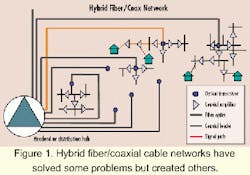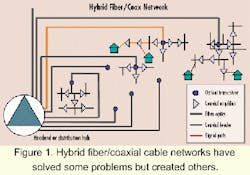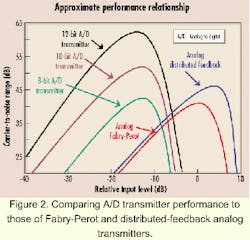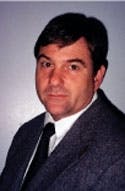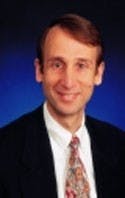Digital solution for an analog environment
A hybrid form of return transmitter shows several advantages over Fabry-Perot and DFB analog laser transmitters.
BY DON GALL AND MITCH SHAPIRO
Hybrid fiber/coax (HFC) networks were adopted by the cable-television industry in the early 1990s. They allowed the industry to upgrade its large and fragile coaxial networks to an architecture that could theoretically approach 99.999% reliability. In practice, "five nines" is a hard level of reliability to achieve-for several reasons.
One issue is that many HFC networks were designed to use as little fiber-optic cable and electronics as possible to limit the upfront capital costs. The end result was relatively large node sizes and still-significant numbers of coaxial amplifiers in cascade (see Figure 1). As a result, these HFC networks were able to reduce but not eliminate problems related to the reliability of network components and their meantime to repair. At the same time, another important system uptime bottleneck emerged within the optical portion of HFC architectures-the dynamic range of the return laser transmitters.
In almost every cable-TV system design, the laser transmitter and receiver have historically been analog devices. Because of this limitation, the carrier to interference, intermodulation products, and overall dynamic range of the device becomes much smaller than its all-digital counterparts. In the forward (downstream) segment of the network, that is not an issue. Its source is a very stable headend or hub that is temperature-controlled.The return (upstream) portion, on the other hand, will work with lower-quality requirements but needs a much larger dynamic range. The analog sources are generated by equipment in the subscriber's home, and the range of signal levels converging on the return laser transmitter can vary dramatically.
As a result, it is not unusual to have radio-frequency (RF) signal levels set incorrectly in the middle of the network even though the level is correct at the ends. That can drastically affect the quality of the signal. To compound matters, the analog RF band used by cable operators has a multitude of other signal sources that can leak into and degrade the network.
The return laser transmitter located in the optical transceiver or node is the weakest link in the network when considering dynamic range. If the RF signal falls outside the optimum range, the quality falls off sharply.
Until recently, there were two choices for analog return lasers: an uncooled analog Fabry-Perot (FP) or distributed-feedback (DFB) laser. The FP transmitter had a dynamic range of typically 20 to 30 dB over a temperature range of -40° to +60°C and a 6-8-dB optical link. The temperature range is a standard used within the cable industry, and solid-state thermal-electric-cooler temperature-controlled devices draw too much current and typically don't have the range to cover the extremes. A DFB will have 25-35 dB of dynamic range over the same optical link. To put this in perspective, the coaxial portion of the network has a dynamic range in excess of 60 dB!
A third choice of return transmitter has emerged. These devices are hybrids that use a digital laser transmitter coupled with an analog-to-digital (A/D) converter. They have several performance advantages over FP and DFB analog laser transmitters. They also have been engineered to survive in the same environment and will fit into approximately the same footprint and power requirement.
One of the first considerations in digitizing the return band (5-40 MHz) is the sampling rate. The first rule to consider is the Nyquist theory, which states that the sampling rate must be at least twice the highest frequency of the signal being sampled. Because of filter considerations, most manufacturers will typically pick a sampling rate of at least 100 MHz (2x40 plus filter design considerations). That means the parallel output of the A/D will be running at 100 million digital words/ sec.
The Nyquist theory plus filtering is also one of the major design limitations for A/D converters. The device used in this application is relatively inexpensive and has multiple sources. The current practical frequency limit is approximately 200 MHz, without getting into expensive, exotic A/D converters and digital filters. At 200 MHz, the clock frequency would be at 400 MHz and the data rate using a 10-bit word would be close to 5 Gbits/sec.
The output of the A/D converter is a parallel signal, with entire words appearing at the output, the first bit on lead one, the second bit on lead two, and so on. The quality of the signal is directly related to the size of the digital word. The size of the word is important, because it defines how finely the analog signal can be resolved, which in turn sets the theoretical carrier-to-noise (C/N) and dynamic range. Since the size of the word also defines the data rate, words larger than 12 bits long are impractical for the application. An 8-bit-word A/D transmitter has approximately the same dynamic range as a very good analog FP equivalent. A 10-bit A/D transmitter outperforms both the FP and DFB analog transmitters (see Figure 2).To transport the digital output of the A/D device, the data must be put into a serial format. Using the 10-bit word as an example, at 100 million words/sec, the raw data rate would be 10 times 100 million, or 1 Gbit/sec. The raw data is then formatted and forward error correction is added, which brings the final data rate to approximately 1.2 Gbits/sec.
Besides dynamic range, this new class of return laser transmitters has optical link budgets of over 20 dB. Their analog counterpart typically has a range of less than 10 dB. The 10- and 12-bit A/D versions also deliver better C/N numbers with a lower input range. The digital output can be time-division multiplexed to allow two or more return lasers on the same fiber. In the headend, the digital signal can be processed and distributed easier than the analog counterpart, since the native format of all the services in the return is digital.
Clipping in analog laser transmitters has always been a concern. When the laser is clipped, the output essentially is shut down until the signal overload is removed. If the clip lasts long enough, the modem (or equivalent device) will believe that the session has been terminated and have to start over. Short-duration overloads will usually just lose packets. The A/D transmitters, on the other hand, will reach a maximum word value and transmit that word value until the level drops back into range. If the overload is during the sample time of a desired signal, packets will be lost. If the overload is from interference that is out of the desired signal's bandwidth, then little harm is done.
We believe this new type of return laser is another milestone on the path to achieving the overall reliability necessary to deliver advanced digital services.Mitch Shapiro has been tracking and analyzing the broadband industry for more than 12 years. He currently directs the strategic research program of Broadband Markets, which develops and markets proprietary databases, financial modeling tools, and strategic reports focused on the competitive broadband industry. He can be reached at [email protected].
